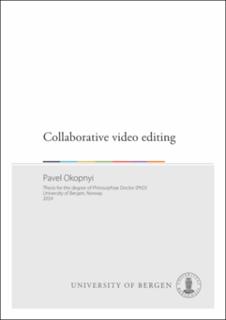| dc.contributor.author | Okopnyi, Pavel | |
| dc.date.accessioned | 2024-01-18T08:23:05Z | |
| dc.date.available | 2024-01-18T08:23:05Z | |
| dc.date.issued | 2024-01-26 | |
| dc.date.submitted | 2024-01-06T01:39:10Z | |
| dc.identifier | container/04/77/01/77/04770177-366d-4ef8-b040-21fa4434411f | |
| dc.identifier.isbn | 9788230864432 | |
| dc.identifier.isbn | 9788230844083 | |
| dc.identifier.uri | https://hdl.handle.net/11250/3112357 | |
| dc.description.abstract | Samarbeid i videoredigering
Denne avhandlingen tar opp følgende spørsmål: Hvordan kan vi støtte samarbeid i videoredigering? I ulike anvendelsesområder, som skriving og design, er bruk av samarbeidsverktøy utbredt. Likevel er programvare for videoredigering i hovedsak utviklet for individuell bruk. Videoredigering bør forstås som en sosial aktivitet og blir i profesjonelle sammenhenger ofte utført som et samarbeid mellom ulike aktører.
Basert på intervjuer og designverksteder, undersøker denne avhandlingen hvordan videoredigerere samarbeider og utforsker mulighetsrommet for å støtte samarbeid i videoredigering gjennom design av nye løsninger.
I tre studier undersøker denne avhandlingen videoredigering fra tre perspektiver. Først undersøker den samarbeidspraksiser blant profesjonelle videoredigerere og identifiserer ulike strategier og sosiale mekanismer som brukes for å oppnå enighet mellom aktørene som er involvert i videoproduksjon. Denne første studien identifiserer ni temaer som beskriver hvordan videoredigerere håndterer usikkerhet og oppnår enighet, spesielt gjennom organisatoriske mekanismer, dokumentasjon og ikoniske referanser. Studien foreslår også tre ulike retninger for design av nye løsninger for å støtte samarbeid i videoredigering.
Det andre studiet undersøker videoproduksjon fra et organisatorisk perspektiv, med fokus på en pågående overgang til distribuert arbeid og dets innvirkning på videoproduksjon. Den andre studien skisserer de kortsiktige og langsiktige implikasjonene av å innføre distribuerte arbeidsformer i TV-produksjonsorganisasjoner under COVID-19-pandemien.
Den siste studien ser på samarbeid i videoredigering som et designproblem og presenterer designideer for hvordan man kan støtte et slikt samarbeid. I tillegg peker denne studien på utfordringer som kan være til hinder for innføringen av nye videoredigeringsverktøy som skal støtte samarbeid.
Ved å sammenstille resultatene fra de tre studiene, samt analysere tidligere forskning og eksisterende videoredigeringsverktøy, identifiserer avhandlingen tre designtilnærminger for å støtte samarbeid i videoredigeringsprogramvare: holistisk, skreddersydd og konfigurerbar. Selv om disse tilnærmingene diskuteres med tanke på samarbeid i videoredigeringspraksiser, kan de tilby et bredere analytisk rammeverk for å vurdere utformingen av samarbeidsverktøy også for andre anvendelsesområder. | en_US |
| dc.description.abstract | This thesis addresses the following question: how can collaboration be supported in video editing? In many domains, such as writing and design, collaborative tools have become common and widespread. However, video-editing software is still predominantly designed for solo users. Nevertheless, video editing is a social activity that, in a professional setting, often involves various people working together.
Based on interviews and design workshops, this thesis investigates the collaborative practices of video editors and explores the design space of collaborative video editing.
In three studies, this thesis looks at video editing from three angles. First, it investigates the collaborative practices of video editors and identifies the strategies and social mechanisms they employ to reach agreements with various parties involved in the videoproduction process. The first study identifies nine themes that characterise the ways video editors manage uncertainties and reach agreements, particularly through organisational mechanisms, documentation, and iconic referencing. The study also suggests three design paths to explore further.
Second, it examines video production from an organisational point of view, focusing on the recent shift towards remote work and its impact on video production. The second study delineates the short-term and long-term implications of adopting remote work in TV production organisations during the COVID-19 pandemic.
Third, it approaches collaborative video editing as a design problem and offers design ideas to enhance collaboration. Additionally, it uncovers challenges that might impede the adoption of new collaborative video-editing tools.
In synthesising the results of the three studies, as well as analysing previous research and existing video-editing tools, this thesis identifies three design approaches for supporting collaboration in video-editing software: holistic, tailored, and configurable. While discussed in the context of collaborative video editing, these approaches offer a broader analytical framework for considering the design of collaborative production tools. | en_US |
| dc.language.iso | eng | en_US |
| dc.publisher | The University of Bergen | en_US |
| dc.relation.haspart | Paper 1: Pavel Okopnyi, Oskar Juhlin, and Frode Guribye. Unpacking Editorial Agreements in Collaborative Video Production, ACM International Conference on Interactive Media Experiences (IMX ’20) 17, 6, 2020. The article is not available in BORA due to publisher restrictions. The published version is available at: <a href="https://doi.org/10.1145/3391614.3393652" target="blank">https://doi.org/10.1145/3391614.3393652</a> | en_US |
| dc.relation.haspart | Paper 2: Pavel Okopnyi, Frode Guribye, Valentina Caruso & Oskar Juhlin, Automation and redistribution of work: the impact of social distancing on live TV production, Human–Computer Interaction 38, 1, 1-24, 2023. The article is available at: <a href="https://hdl.handle.net/11250/2989485" target="blank">https://hdl.handle.net/11250/2989485</a> | en_US |
| dc.relation.haspart | Paper 3: Pavel Okopnyi, Oskar Juhlin, and Frode Guribye, Designing for Collaborative Video Editing, Nordic Human-Computer Interaction Conference (NordiCHI ’22), 3, 2022. The article is available at: <a href="https://hdl.handle.net/11250/3113047" target="blank">https://hdl.handle.net/11250/3113047</a> | en_US |
| dc.rights | Attribution-NonCommercial (CC BY-NC). This item's rights statement or license does not apply to the included articles in the thesis. | |
| dc.rights.uri | https://creativecommons.org/licenses/by-nc/4.0/ | |
| dc.title | Collaborative video editing | en_US |
| dc.type | Doctoral thesis | en_US |
| dc.date.updated | 2024-01-06T01:39:10Z | |
| dc.rights.holder | Copyright the Author. | en_US |
| dc.contributor.orcid | 0000-0001-7034-2733 | |
| dc.description.degree | Doktorgradsavhandling | |
| fs.unitcode | 15-17-0 | |

